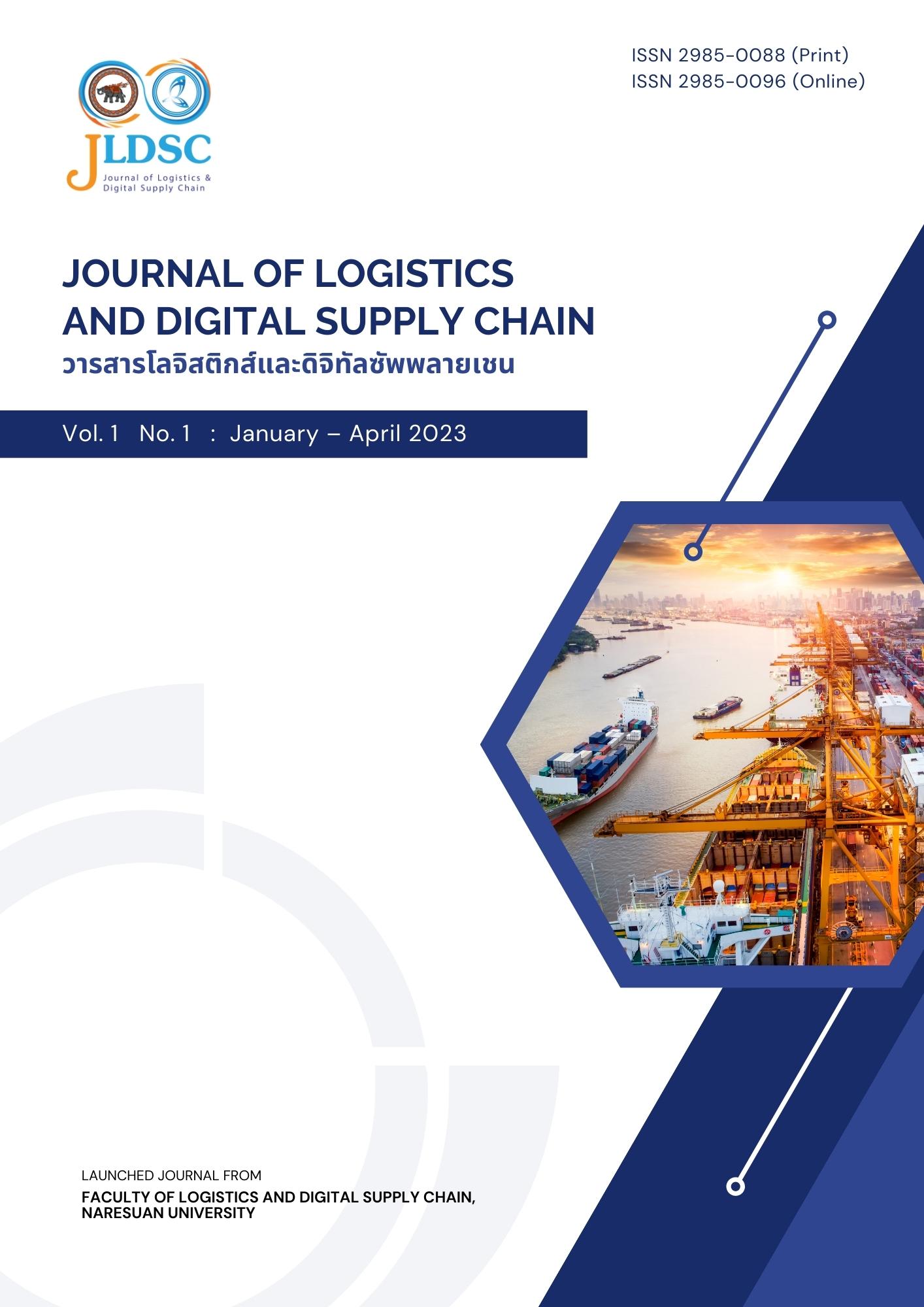กรอบแนวคิดสำหรับการพัฒนาแบบจำลองแนะนำเส้นทางอัจฉริยะ สำหรับระบบขนส่งสาธารณะแบบยืดหยุ่น
Main Article Content
บทคัดย่อ
รูปแบบการขนส่งสาธารณะแบบยืดหยุ่นแบบไม่ประจำทางนั้น จะมีการเส้นทางที่มีความยืดหยุ่นตามความต้องการในการเรียกใช้ของผู้โดยสารไปยังปลายทางที่ผู้โดยสารต้องการ ซึ่งการจัดการเพื่อให้เกิดประสิทธิภาพสูงสุดต้องอาศัยการจัดเส้นทางแบบยืดหยุ่น (Flexible route) ที่สามารถจัดเส้นทางให้รถโดยสารในกลุ่มไปรับและส่งผู้โดยสารในแบบเวลาจริง (real-time) บทความนี้เป็นการอภิปรายแบบจำลองในการจัดเส้นทางแบบยืดหยุ่นและการนำปัญญาประดิษฐ์ (Artificial Intelligence: AI) ด้วยแบบจำลอง Long-Short Term Memory (LSTM) มาช่วยในการคาดการณ์ความต้องการของการเรียกรถโดยสารของผู้โดยสารเพื่อใช้ในการปรับปรุงข้อมูลปริมาณและพื้นที่ความต้องการในการเรียกรถโดยสาร ผลที่ได้จากแบบจำลองจะช่วยลดความสูญเปล่าในการเดินทางของรถโดยสารและส่งผลให้เกิดความพึงพอใจเพราะสามารถเดินทางไปถึงจุดหมายได้ในเวลาที่รวดเร็ว และสามารถพัฒนาต่อเป็นอัลกอรึทึม (algorithm) ร่วมกับระบบเทคโนโลยีสารสนเทศเพื่อนำไปใช้งานจริงได้
Article Details

อนุญาตภายใต้เงื่อนไข Creative Commons Attribution-NonCommercial-NoDerivatives 4.0 International License.
เอกสารอ้างอิง
Agra, A., Christiansen, M., Figueiredo, R., Hvattum, L. M., Poss, M., & Requejo, C. (2013). The robust vehicle routing problem with time windows. Computers and Operations Research, 40(3), 856–866.
Aiko, S., Thaithatkul, P., & Asakura, Y. (2018). Incorporating User Preference into Optimal Vehicle Routing Problem of Integrated Sharing Transport System. Asian Transport Studies, 5(1), 98-116.
Baños, R., Ortega, J., Gil, C., Fernández, A., & de Toro, F. (2013). A Simulated Annealing-based parallel multi-objective approach to vehicle routing problems with time windows. Expert Systems with Applications, 40(5), 1696–1707.
Blum, C., & Roli, A. (2003). Metaheuristics in combinatorial optimization: Overview and conceptual comparison. ACM Computing Survey, 35(3), 268-308.
Crevier, B., Cordeau, J. F., & Laporte, G. (2007). The multi-depot vehicle routing problem with inter-depot routes. European Journal of Operational Research, 176(2), 756–773.
Dantzig, G. B., & Ramser, J. H. (1959). The Truck Dispatching Problem, Management Science, 6(1), 80-91.
Figliozzi, M. A. (2010). An iterative route construction and improvement algorithm for the vehicle routing problem with soft time windows. Transportation Research Part C: Emerging Technologies, 18(5), 668–679.
Gendreau, M., Laporte, G., & Séguin, R. (1996). A Tabu Search Heuristic for the Vehicle Routing Problem with Stochastic Demands and Customers. Operations Research, 44(3), 423-528.
Gendreau, M., Laporte, G., & Séguin, R. (1995). An Exact Algorithm for the Vehicle Routing Problem with Stochastic Demands and Customers. Transportation Science, 29(2), 143-155.
Giuffrida, N., Fajardo-Calderin, J., Masegosa, A. D., Werner, F., Steudter, M., & Pilla, F. (2022). Optimization and Machine Learning Applied to Last-Mile Logistics: A Review. Sustainability, 14(9), 1-16.
Ho, W., Ho, G. T. S., Ji, P., & Lau, H. C. W. (2008). A hybrid genetic algorithm for the multi-depot vehicle routing problem. Engineering Applications of Artificial Intelligence, 21(4), 548–557.
Hulagu, S., & Celikoglu, H. B. (2022). An Electric Vehicle Routing Problem with Intermediate Nodes for Shuttle Fleets. IEEE Transactions on Intelligent Transportation Systems, 23(2), 1223–1235.
Li, B., Krushinsky, D., Reijers, H. A., & van Woensel, T. (2014). The Share-A-Ride Problem: People and parcels sharing taxis. European Journal of Operational Research, 238(1), 31–40.
Li, J., Li, Y., & Pardalos, P. M. (2016). Multi-depot vehicle routing problem with time windows under shared depot resources. Journal of Combinatorial Optimization, 31(2), 515–532.
Lin, Y., Li, W., Qiu, F., & Xu, H. (2012). Research on Optimization of Vehicle Routing Problem for Ride-sharing Taxi. Procedia - Social and Behavioral Sciences, 43(1), 494–502.
Liyanage, S., Abduljabbar, R., Dia, H., & Tsai, P. W. (2022). AI-based neural network models for bus
passenger demand forecasting using smart card data. Journal of Urban Management, 11(3), 365–380.
Ma, B., Hu, D., Chen, X., Wang, Y., & Wu, X. (2021). The vehicle routing problem with speed optimization for shared autonomous electric vehicles service. Computers and Industrial Engineering, 161(1), 1-17.
Petit, A. and Ouyang, Y. (2022). Design of heterogeneous flexible-route public transportation networks under low demand. Transportation Research Part C: Emerging Technologies, 138(1), 1–22.
Polacek, M., Hartl, R. F., Doerner, K., & Reimann, M. (2004). A Variable Neighborhood Search for the Multi Depot Vehicle Routing Problem with Time Windows. Journal of Heuristics, 10(1), 613–627.
Talbi, E. G. (2009). Metaheuristics From Design to Implementation. Canada: John Wiley and Sons.
Taş, D., Dellaert, N., van Woensel, T., & de Kok, T. (2013). Vehicle routing problem with stochastic travel times including soft time windows and service costs. Computers and Operations Research, 40(1), 214–224.
Tholen, M., Beirigo, B. A., Jovanova, J., & Schulte, F. (2021). The Share-A-Ride Problem with Integrated Routing and Design Decisions: The Case of Mixed-Purpose Shared Autonomous Vehicles. Computational Logistics: Proceedings of the 12th International Conference (pp. 347-361). Enschede, The Netherlands : Springer.
Vidal, T., Crainic, T. G., Gendreau, M., & Prins, C. (2013). A hybrid genetic algorithm with adaptive diversity management for a large class of vehicle routing problems with time-windows. Computers and Operations Research. 40(1), 475–489.
Xiao, W., and Xu, H. (2022). A novel bus scheduling model based on passenger flow and bus
travel time prediction using the improved cuckoo search algorithm. 2022 International
Conference on Big Data, Information and Computer Network (BDICN). China : Sanya .
Zhang, C., Zhu, F., Wang, X., Sun L., Tang H., and Lv, Y. (2022). Taxi Demand Prediction Using Parallel Multi-Task Learning Model. IEEE Transactions on Intelligent Transportation
Systems, 23(2), 794-803.


